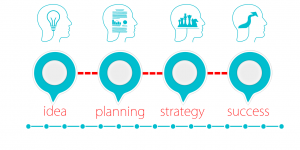Lead time and cycle time are widely used terms in the Kanban world.
CONTENT
However, quite often, people get confused when trying to understand the difference between them and their significance.
For the sake of dispelling doubts once and for all regarding the identification and differentiation between Cycle Times and Lead Times, we have decided to shed some light on the matter with this article.
What is Cycle Time?
Cycle time is basically simply the amount of time it takes for a task to get from a “In Progress” state to a “Completed” one.
The clock starts ticking on the cycle time as soon as the task goes from a “Ready” state to a “In Progress” state and stops ticking when the work element goes from a “In Progress” state to a “Completed” one.
What exactly these states mean will vary depending on the work and context.
If the work element moves back and forth, for example because the client changes their mind or doesn’t accept the work and insists that it be modified or done again (you might be interested in this article on how to manage change requests on a project), the clock won’t reset, but it will continue to tick.
Cycle time is a very important measure that portrays the efficiency of a system in processing units of work.
However, it has nothing to do with what happens outside of that system, such as the queue to put work into that system. That’s where lead time or delivery time comes into play.
What is Lead Time?
The business environment is dynamic and produces new customer requests continuously, and these requests reach the organization as work requests.
Lead Time is the length of time between the occurrence of a new task in the workflow (“queued” status) and its final release from the system (“completed” status).
Lead Time is therefore inevitably always longer than Cycle Time.
Lead Time and Cycle Time Example
If these two concepts still sound confusing, here’s an example to straighten things out.
Let’s imagine a coffee shop with a barista, a cashier and some customers. As soon as the customer orders a coffee from the cashier, that work goes into the queue. That is, the customer has placed an order for a coffee and expects to receive it as soon as possible. The Lead Time clock has therefore started ticking. If there are no other orders in the system, the barista can start brewing coffee right away. As soon as the barista starts working on that coffee, the Cycle Time clock starts ticking.
Cycle time is simply the time needed by the barista to prepare a coffee. The only way to improve it is for the barista to become faster at brewing coffee.

If the barista can start brewing a coffee the very second an order is placed, the delivery time is equal to the cycle time.
But if orders start coming in faster than a barista can make coffees, orders will pile up.
If the barista can make a coffee in one minute, but a coffee order comes in every 20 seconds, the cycle time remains at one minute, but the delivery time will begin to increase continuously as orders pile up.
Professor John Little (MIT professor) came to the conclusion after various researches that the more work you have in progress, the greater the cycle time of the system.
The equation has come to be known as Little’s Law:
Cycle time = work in progress / productivity
How can you reduce the gap between lead time and cycle time?
Sometimes, a task can spend considerable time in a waiting status before a team member is able to start working on it.
This leads to a larger gap between lead time and cycle time, and as a result, tasks reach the completion stage more slowly.
To find the source of this problem, you can use two analysis tools:
- Cycle time scatterplot
- Heatmap
The Scatterplot provides extensive information about the cycle time of all tasks over a predetermined period of time.
In this way, you can identify the tasks that took the longest amount of time to complete.
The heatmap shows data for the total amount of time activities spend in different stages of the workflow.
It can help you understand where tasks spend the most time as the workflow progresses.
Both tools will help you pinpoint which parts of a work process are troublesome and take action to fix them.
You need to remember that work is in fact a continuous process and is constantly changing.
Therefore, you need to monitor the workflow regularly and use the appropriate analytical tools.




